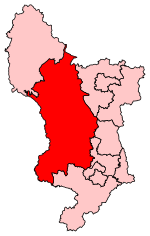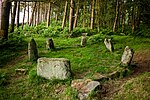Birchover
Civil parishes in DerbyshireDerbyshire DalesDerbyshire geography stubsTowns and villages of the Peak DistrictVillages in Derbyshire

Birchover is a village and civil parish in the Peak District National Park in Derbyshire, England, five miles north-west of Matlock. At the 2001 Census, it had a population of 362. Eagle Tor is a small hamlet on the north western edge of the parish.
Excerpt from the Wikipedia article Birchover (License: CC BY-SA 3.0, Authors, Images).Birchover
Birchover Lane, Derbyshire Dales
Geographical coordinates (GPS) Address Nearby Places Show on map
Geographical coordinates (GPS)
| Latitude | Longitude |
|---|---|
| N 53.15 ° | E -1.65 ° |
Address
Birchover Lane
Birchover Lane
DE4 2BH Derbyshire Dales
England, United Kingdom
Open on Google Maps











